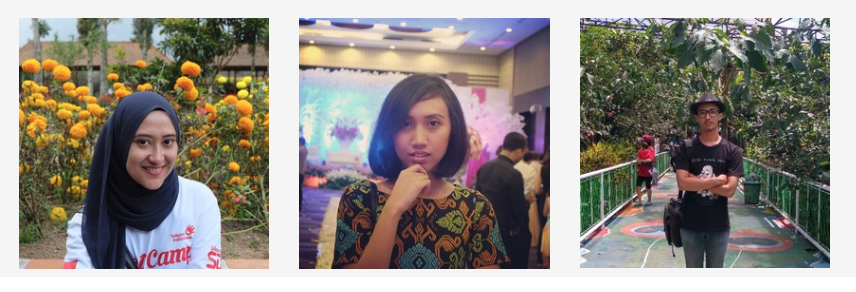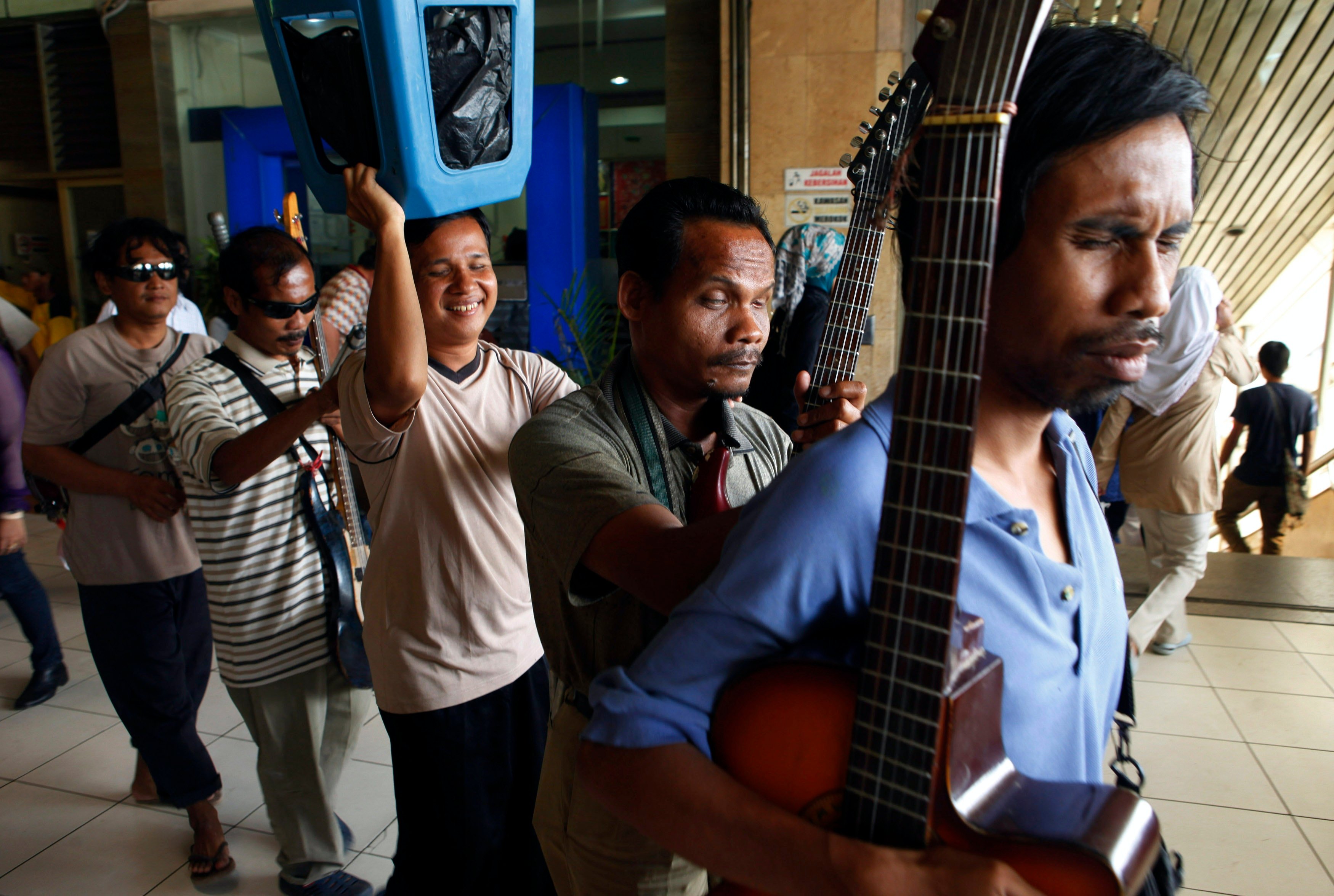Indonesia: A New App to Help Persons with Visual Impairment Navigate Their Cities
October 09, 2018
On the streets of Indonesia, drivers of big buses and hulking trucks act like kings. Long granted hegemony on the road, they dominate the country’s highways, forcing pedicabs and motorcycles to relent when using the same lane.
Pedestrians have it worse – they are effectively the lowest caste on Indonesian streets. Rarely are they granted acceptable sidewalks; those that exist are not always safe, and more often than not, streets lack them altogether.
For Indonesia’s disabled pedestrians, the situation is even more dire.
It is no exaggeration to say that for disabled pedestrians, especially for the blind, leaving the house is like looking for harm. They are greeted with uneven roads, unpredictable holes in sidewalks, dangling electrical wires, and rubbish scattered haphazardly on the road, just waiting to cause an accident.
There are an estimated 3.6 million blind people in a country with a total population of 265 million. Their rights are often overlooked by government officials, and public facilities are seemingly designed without much regard to their needs.
However, Indonesia’s blind population has a new team of advocates: Gita Nofieka, Dwijayati Pravitasari, and Madhan Al Askarivy. They are the creators of TuneMap, a digital map application created to help the blind navigate Indonesia’s treacherous streets.
 Credit: Tunemap.org ScreenshotThe creators of TuneMap: Dwijayati Pravitasari (left), Gita Nofieka (middle), Madhan Al Askarivy (right).
Credit: Tunemap.org ScreenshotThe creators of TuneMap: Dwijayati Pravitasari (left), Gita Nofieka (middle), Madhan Al Askarivy (right).The beginning of TuneMap
The three young Indonesians started TuneMap once they witnessed a difference between the treatment of the blind abroad and back home. Nofieka pursued her Masters in the UK and observed their well-established facilities for disabled people. The most eye-opening experience, she said, was when she attended “Tourism for All” training and learned about disabled-friendly tourism that strives to be friendly to all disabled people, including wheelchair users and the blind. From this, Nofieka and her co-creators decided to make their homeland friendlier to its disabled residents.
Indonesia’s disabled population faces societal neglect, stemming from disrespect from the able-bodied populace to unequal rights and opportunities. Nofieka and her friends chose to focus their attention on those with visual impairments as they believed their disability was particularly maligned in Indonesian society.
Indonesian disability statistics suffer greatly from a lack of available, current data. Digging into data from the Ministry of Education and Culture in the mid-2000s shows that, at the time, the school participation rate of blind children was as low as 10 percent. The other 90 percent lived at home, denied a chance to study with their peers.
This social isolation lends itself to an already practical fear among the blind of daring to walk outside, and it served as the genesis of TuneMap.
What exactly is TuneMap?
To be precise, TuneMap is a crowd-sourcing sight platform to navigate visually impaired people in cities across Indonesia. The goal is to provide independence for the blind to be able to travel safely and comfortably, even if alone.
“The app also allows others, including non-blinds, to contribute by capturing road conditions and [giving] more thorough information, i.e. unpaved roads, holes, the absence of guiding blocks, etc. and [sending] them through TuneMap,” Nofieka told The News Lens. “The data is then processed into navigation for [blind people].”
 Credit: Tunemap.org ScreenshotTuneMap allows users to submit reports of real-time road conditions.
Credit: Tunemap.org ScreenshotTuneMap allows users to submit reports of real-time road conditions.Nofieka and her team launched a campaign called Map My Day, inviting the wider community to contribute as volunteers to map accessibility conditions and report any abnormalities that may cause danger to blind people on sidewalks. Through the app, residents can also mark safe points, helping blind people plan their routes.
“This collective mapping is a simple, effective way to involve all components of society in working together to build sustainable cities and harmonious urban communities,” said Nofieka.
Beyond reporting road conditions, TuneMap can also provide data on nearby public buildings and facilities such as ATMs, public toilets, and parking spaces.
With enough user-generated data, the app has the potential to serve a purpose beyond helping blind people, allowing community members and maintenance workers to know the locations of poor road conditions in real time.
Indonesia itself does not have an online repository to access such information, so the maintenance and repair of damaged roads is generally carried out after complaints from the community or field surveys. Nofieka said TuneMap’s data could be a cheap, easy, and fast long-term solution for the government to maintain and monitor public facilities for the benefit of its citizens.
Communities can also directly monitor whether there has been improvement in reported damaged or unsafe areas. Nofieka said the government response to reported problems is often slow, or completely ignored. She says potholes can often stay unrepaired for up to a year, despite public complaints.
Set to launch later this year, TuneMap is currently conducting market research to explore potential innovations. It’s also soliciting continued feedback from its blind users on how they use smartphones, fiddling with button placement and its utilization of voice commands so that blind people can easily use the app. TuneMap is collaborating with disabled communities and institutions, along with special needs schools, to improve its functionality.
Can the government meet the needs of its disabled residents?
Indonesia’s disabled suffer doubly from the difficulties of living with their physical and/or mental limitations, along with the lack of support and acceptance from their communities and government officials, leading to their inability to secure the same opportunities for education and work enjoyed by their able-bodied peers.
The situation began to improve when the government implemented the Social Security for Persons with Disabilities program in 2006. The policy was seen as far from perfect from the outset, and President Joko “Jokowi” Widodo set about to improve it once he took office in 2014. Through the Ministry of Social Affairs, his administration provided funding to a program called Social Assistance of Persons with Severe Disabilities (ASPDB). Those enrolled in this program could receive benefits from Jokowi’s signature Healthy Indonesia Card (KIS) and the Smart Indonesia Card (KIP) programs. In 2018, ASPDB was incorporated into a larger benefits scheme under the Ministry of Social Affairs called Program Keluarga Harapan (PKH).
 Credit: Reuters / TPGA group of blind musicians hold onto one another as they walk in Tanah Abang train station in Jakarta on March 24, 2011.
Credit: Reuters / TPGA group of blind musicians hold onto one another as they walk in Tanah Abang train station in Jakarta on March 24, 2011.So, has ASPDB been an effective program for upwards of 10 million disabled people in Indonesia? Unfortunately, not yet. Because it is included in the PKH program, there are no criteria to determine which recipients should receive priority – it is targeted at disabled people in general. Like Jokowi’s KIS and KIP programs, the main goal of PKH is to eradicate poverty; it has not shown that it has a specific focus on improving life for disabled people in general.
Access to education and other social services also remains a problem for people with a disability in Indonesia. Of 37 million disabled people tracked by studies, only a small number succeed in completing education up to university level. Some cannot access education at all, rejected by public schools even at the kindergarten level. When they are fortunate enough to be educated, they go without necessary facilities and assistance. If they make it to higher education, they often move around to find schools which can, and are willing to, accept their conditions.
Due to their lack of education, many disabled Indonesians are left with limited access to well-paid employment. They are frequently denied from certain jobs as they are perceived as incapable. Employers, in many cases, clearly discriminate against qualified candidates who also happen to be disabled. This leads to many disabled people being significantly less financially stable than their counterparts.
For those disabled Indonesians who are employed, of course, there’s still the challenge of getting to work. While there has been an increase in public services providing access to the disabled, Indonesia still lags far behind much of the world. Most bus services are not wheelchair friendly, lacking space for passengers with wheelchairs or platforms to help them enter and exit the bus.
Pedestrians face many of the same problems. Most pedestrian paths are unsafe and unpassable; damaged and littered with holes. Wheelchairs are relegated to the street alongside cars, motorbikes, buses and trucks.
 Credit: TuneMapSnapshots from Indonesian streets and sidewalks.
Credit: TuneMapSnapshots from Indonesian streets and sidewalks.Nofieka, Pravitasari, and Al Askarivy are not content with waiting for the government to take comprehensive action to solve these problems – instead, they aim to take the first small yet significant step.
Ahead of its anticipated launch before the year’s end, TuneMap has been boosted by funding from the UN Volunteer Asia Pacific along with a US$7,000 (NT$214,888) prize from the UN’s Youth Volunteering Innovation Challenge. It has also began to introduce itself to local governments, such as those in Bandung and Bogor, for cooperation. Although Nofieka says it has received positive responses, no formal agreements with governments have been reached as of yet.
The team plans to increase their cooperation with government institutions after the app is officially launched. “Of course we need to cooperate with government institutions to make public facilities in the country more accessible,” said Nofieka.
At the very least, the TuneMap team hopes their app will serve as a wake-up call for the government to address the practical needs of Indonesia’s disabled residents. Indonesia’s 3.6 million strong blind population surely hopes for the same.
Source: The News Lens

